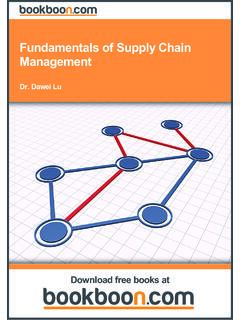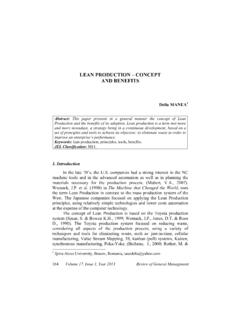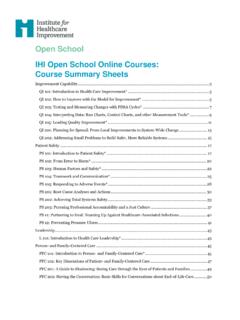Transcription of Origins of lean management in Origins of lean America
1 Origins of lean management inAmericaThe role of Connecticut EmilianiSchool of Technology, Central Connecticut State University, New Britain,Connecticut, USAA bstractPurpose The purpose of this paper is to provide a historical account of the significant role thatConnecticut businesses and business leaders had in the spread of lean management throughout theUSA. The paper aims to describe what happens when managers do not understand and apply animportant principle of lean Survey of published and unpublished records, as well aspersonal communications with key Establishes the role and importance of Connecticut businesses and business leaders in thediscovery and dissemination of lean management in America since 1979.
2 External to Toyota and itsaffiliated limitations/implications The accuracy of some past events necessarily relies on therecollection of key figures that were obtained by personal implications Describes how an important principle, respect for people, was notunderstood by most management practitioners, thus hindering efforts to correctly practice Leanmanagement and improve business The paper provides a historical account of lean management in America ,focusing on activities that occurred in the State of Connecticut post-1979. Description and relevance ofa key area of misunderstanding among practitioners of the lean management technique, lean production, Manufacturing systems, History,Automotive industry, United States of AmericaPaper typeResearch paperIntroductionToyota Motor Corporation is widely recognized for having created an important newmanagement system that top managers of many manufacturing and servicebusinesses now seek to emulate.
3 Toyota s management system is variously referredto as Toyota Production System (Ohno, 1988a), Toyota management System (Monden, 1993), lean Production, (Womacket al., 1990) or lean management (Emilianiet al., 2003). It is also commonly referred to as lean manufacturing due toits Origins in production and operations management (Shingo, 1981; Ohno, 1988a).However, this description implies a narrow focus and is now recognized as incorrectbecause lean principles and practices can be applied to any organization. Thus, theemergent preferred description for this management system external to Toyota MotorCorporation is lean management .
4 The roots of Toyota s management system dates to the early 1890s, whenself-taught inventor Sakichi Toyoda designed and patented a manually operated loomfor weaving cloth that greatly improved worker productivity and the quality of theThe current issue and full text archive of this journal is available of leanmanagement inAmerica167 Journal of management HistoryVol. 12 No. 2, 2006pp. 167-184qEmerald Group Publishing Limited1355-252 XDOI (Kimoto, 1991; Togo and Wartman, 1993; Reingold, 1999; Wada and Yui, 2002). Inthe 1920s, Sakichi s son, Kiichiro, designed and patented many new loom features,including improved mechanisms invented by his father that would automatically stopthe machine when a thread broke, thus avoiding the production of defective cloth(Kimoto, 1991; Wada and Yui, 2002).
5 In part as a result of these innovations, keyobjectives of Toyota s early management practice have been characterized as production efficiency by consistently and thoroughly eliminating waste , and theequally important respect for humanity (Ohno, 1988b).Two people are widely credited for having created the Toyota Production System asit is known today: Ohno (1988a), who rose to the level of Executive Vice President ofToyota Motor Corporation, and Shingo (1985), a consultant to Toyota employed by theJapan management Association, famous for his work on single-minute exchange ofdies.
6 Toyoda (1985), former President of Toyota Motor Corporation, and Saito Naichialso played key roles (Ohno and Mito, 1988; Womacket al., 1990; Womack and Jones,1996).Both Kiichiro Toyoda and Taiichi Ohno were greatly influenced by Americanindustrialists and their production and management practices (Ohno, 1988a; Toyota,1988), but not by management theorists. By far the most influential person was HenryFord, through his booksMy Life and My WorkandToday and Tomorrow(Ford andCrowther, 1922, 1926). Another highly influential management practice was the Training Within Industry Service (TWI), a structured four-step program for trainingmanufacturing workers particularly supervisors (Huntzinger, 2005).
7 TWI wascreated by the US government in the 1940s to increase wartime production. It came toJapan in the early 1950s (Fujimoto, 1999) as part of allied efforts to rebuild industrialinfrastructure. Kiichiro Toyoda, Taiichi Ohno, and Shigeo Shingo were likely familiarwith Taylor s (1911) bookThe Principles of Scientific management . However, Taylor swork appears to have not made significant direct contribution to the evolution ofToyota s management system. It is more likely to have influenced Toyota managersthrough their understanding of Ford s system of production (Fujimoto, 1999).While the influence of western industrial management practice is clear, it is veryimportant to recognize that it is also rather limited.
8 Toyota managers have, overgenerations, purposefully made many very important improvements to industrialmanagement practice over time (Shingo, 1981; Ohno, 1988a; Womacket al., 1990;Monden, 1993, 1998; Basu, 1999; Fujimoto, 1999), consistent with the dual objectives of production efficiency by consistently and thoroughly eliminating waste and theequally important respect for humanity (Monden, 1983; Ohno, 1988a). While thesewere the major drivers, Japanese business conditions and Japanese culture playedrecognizable but less significant roles (Ohno, 1988a; Nishiguchi, 1994; Basu, 1999;Fujimoto, 1999; Wada and Yui, 2002).
9 There is no direct connection between the theoretical development of westernmanagement thought over the last 100 years and the evolution of Toyota smanagement system. This reflects both a lack of formal management training amongkey personnel, as well as a strong belief among Toyota managers that they must bevery practical, see reality clearly, understand the true nature of problems, and bewilling to challenge existing paradigms (Shingo, 1981; Ohno, 1988a). These attributeswere much more highly regarded among managers than theoretical analysis by themor others (Monden, 1983). In addition, there was a strong interest among ToyotaJMH12,2168managers, since the days of Sakichi Toyoda, to develop production capabilities andmanagement practices that were uniquely Japanese (Toyoda, 1985; Ohno, 1988a;Toyota, 1988, 2001; Wada and Yui, 2002) including contributions of ideas andpractices from Henry Ford and his colleagues, whom they greatly admired.
10 Despitebeing Japanese, the principal architects felt that Toyota s management system could beapplied to any type of business in any country (Shingo, 1981; Ohno, 1988a; Ohno andMito, 1988).Since the late 1970s, lean management has become an important route forimproving the performance of businesses in the USA reducing costs, improvingquality, reducing lead-times, increasing market share, developing new products andservices, human resources, etc. (Imai, 1986; Monden, 1986). Practiced correctly, Leanmanagement can help avoid decisions that result in undesirable trade-offs thatnegatively impact key stakeholders such as employees, suppliers, customers,investors, or communities.




